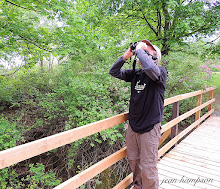December 18
Nature club members and birders from Canada, the United States, Latin America and the Caribbean participate in the annual Christmas Bird Count (CBC) on any one day between December 14 and January 5. Volunteers count birds found within a circle with a diameter of 24 km (15 miles) and it has become an annual tradition for Jean and I. In the Niagara Region, we lend our assistance to 3 Christmas Bird Counts.
The first is the St. Catharines CBC. This year it was held on Sunday December 18. Our group was slightly larger this year and we required two vehicles to cover the rural roads of West Lincoln. John (section coordinator) and Katherine accompanied Dan in his car while Jean and I joined Denys in his van. Birds were spotted as we drove along and at the prime spots, we would exit the vehicles and walk for short distances to pick off birds in the brush, in trees, and at feeders.
The morning temperatures were below freezing. There was little snow and we did have some sun during the first couple of hours of our count. Sufficient sun to create an atmospheric phenomenon known as a sun dog. John (a retired physics professor) directed our attention to the shiny light formed by ice crystals in high and cold cirrus clouds. From what I recall, I don't think I have ever noticed these bright spots in the past. So, shortly after starting the count at 8:00 am (no owl prowls for us), I had a lifer sun dog.
During the 6 hours of birding the group found a total of 34 species. The Northern Shrike was quite the sight, but even better for Jean and I, our group observed 2 Ring-necked Pheasant. A bird that Jean and I needed for the year list. I had spotted a male pheasant in west St. Catharines early in the year for my bird-a-day challenge, but the introduced species did not make the year list since Jean was not with me at the time. In addition to the pheasant, Jean spotted a chicken-like bird running along the lawn in front of us and then disappear into the tall grass. Jean described it as being similar to a Bobwhite and we waited for it to emerge from the brush. We soon discovered the wait was not needed. In a small rectangular fenced enclosure, we spotted 11 Chukars. The mystery bird was an escaped Chukar, another introduced species found in rocky terrain of the western United States. Though countable in Colorado, the free-range Chukar seen in West Lincoln, Ontario was not. I have no problem counting the pheasants for my list though. They could easily be wild birds that are attracted to the feed set out for the domesticated Chukars.
While the morning of our count was filled with a variety of birds, the afternoon was disappointing, a "bust" as described by John. Overall, the final tally currently stands at 75 species for the 2011 St. Kitts birding circle and House Wren was a new species for the count. Rather than chase after the wren once we finished work the next day, Jean and I chose to look for the Snowy Owl observed at the Jordan Harbour marina. In 2008, a Snowy Owl was recorded during the count and Jean and I successfully observed our lifer the following day.
The light was fading fast when we arrived at the harbour and so had the Snowy Owl. There's still a possibility of seeing one before the end of the year. There have been many sightings in southern Ontario recently and when the Niagara Falls CBC occurs in less than a week, a stop at the Niagara District Airport before meeting John and the rest of the crew in Niagara-on-the-Lake just might get us #217 for the year.
Thursday, December 22, 2011
Subscribe to:
Post Comments (Atom)









No comments:
Post a Comment